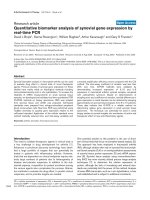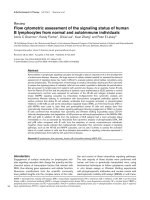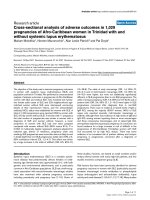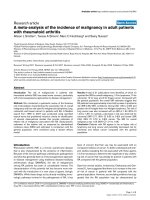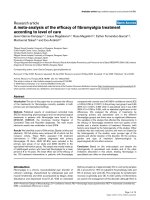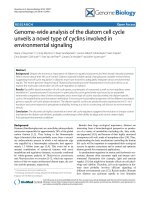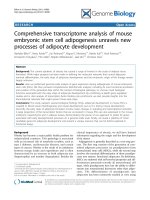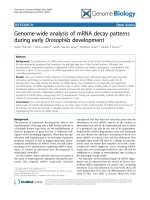Báo cáo y học: "Flow cytometry analysis of glucocorticoid receptor expression and binding in steroid-sensitive and steroid-resistant patients with systemic lupus erythematosus" pps
Bạn đang xem bản rút gọn của tài liệu. Xem và tải ngay bản đầy đủ của tài liệu tại đây (1007.53 KB, 11 trang )
Open Access
Available online />Page 1 of 11
(page number not for citation purposes)
Vol 11 No 4
Research article
Flow cytometry analysis of glucocorticoid receptor expression and
binding in steroid-sensitive and steroid-resistant patients with
systemic lupus erythematosus
Juan Du
1
*, Min Li
2
*, Denghai Zhang
1
, Xiaoyan Zhu
3
, Weiwei Zhang
4
, Wei Gu
1
, Yinglu Feng
1
,
Xiaofeng Zhai
1
and Changquan Ling
1
1
Department of Integrative Medicine, Changhai Hospital, The Second Military Medicine University, No.168 Changhai Road, Shanghai, PR China
2
Department of Naval Medicine, The Second Military Medicine University; No.800 Xiangyin Road, Shanghai, PR China
3
Department of physiology, The Second Military Medicine University; No.800 Xiangyin Road, Shanghai, PR China
4
Department of Medical Technology, Changhai Hospital, The Second Military Medicine University, No.168 Changhai Road, Shanghai, PR China
* Contributed equally
Corresponding author: Changquan Ling,
Received: 9 Jan 2009 Revisions requested: 9 Feb 2009 Revisions received: 9 May 2009 Accepted: 14 Jul 2009 Published: 14 Jul 2009
Arthritis Research & Therapy 2009, 11:R108 (doi:10.1186/ar2763)
This article is online at: />© 2009 Du et al.; licensee BioMed Central Ltd.
This is an open access article distributed under the terms of the Creative Commons Attribution License ( />),
which permits unrestricted use, distribution, and reproduction in any medium, provided the original work is properly cited.
Abstract
Introduction Glucocorticoid (GC) therapy is the main treatment
for systemic lupus erythematosus (SLE). However, some
patients are resistant to these agents. Abnormalities of
glucocorticoid receptor (GR) seem to be related to steroid
resistance. This study evaluated GRs in T lymphocytes and
monocytes of SLE patients by flow cytometry (FCM) using a
monoclonal antibody (mAb) and FITC-Dex probes.
Methods Thirty-five patients with SLE before treatment and 27
age- and sex-matched normal controls were studied. Disease
activity scores were determined before and after treatment and
used to divide the patients into steroid-resistant (SR) and
steroid-sensitive (SS) groups. GRs in T lymphocytes (CD3
+
)
and monocytes (CD14
+
) were examined by FCM with GR-mAb
and FITC-Dex probes before treatment. Peripheral blood
mononuclear cells (PBMCs) were isolated for in vitro GCs
sensitivity assays. The validity of FCM analysis of intracellular
staining for GR with GR-mAb and FITC-Dex probes was
evaluated through comparison with western blot and radioligand
binding assay (RLBA) in U937 and K562 cells in vitro. One-way
ANOVA, student's t test, linear regression and spearman
correlation were performed.
Results A significant decrease in GR binding and the
expression in K562 and U937 cells with 10
-6
M dexamethasone
(Dex) was found compared with those without Dex. In addition,
a positive correlation was found between FCM and RLBA as
well as FCM and Western blot. The expression and binding of
both CD3/GR and CD14/GR in SR patients with SLE, detected
by FCM, were all lower than those in SS patients with SLE,
whereas there was no significant difference in SS patients and
controls. In vitro corticosteroid sensitivity assay indicated that
PHA-stimulated tumour necrosis factor-α (TNF-α), IL-12 and
interferon-γ (IFN-γ) secretion was significantly inhibited by 10
-6
M Dexamethasone in all controls and SS patients, compared
with that in SR group, which confirms patient classification as
SR and SS by disease activity index (SLEDAI) score.
Conclusions Abnormalities of expression and binding of the GR
may be involved in tissue resistance to steroids in SLE patients.
Determination of GR expression and binding by FCM may be
useful in predicting the response to steroid treatment of SLE
patients.
Trial registration Clinical trial registration number
NCT00600652.
ANOVA: analysis of variance; APC: allophycocyanin; Dex: dexamethasone; ELISA: enzyme-linked immunosorbent assay; FCM: flow cytometry; FCS:
fetal calf serum; FITC: fluorescein isothiocyanate; GC: glucocorticoid; GR: glucocorticoid receptor; IFN: interferon; IL: interleukin; mAb: monoclonal
antibody; MFI: mean fluorescence intensity; PBMC: peripheral blood mononuclear cells; PBS: phosphate-buffered saline; PCR: polymerase chain
reaction; PE-CY5: phycoerythrin-CY5; PHA: phytohaemagglutinin; PI: propidium Iodide; RLBA: radiolabelled receptor ligand; SLE: systemic lupus
erythematosus; SLEDAI: SLE Disease Activity Index; SR: steroid-resistant; SS: steroid-sensitive; TNF: tumour necrosis factor.
Arthritis Research & Therapy Vol 11 No 4 Du et al.
Page 2 of 11
(page number not for citation purposes)
Introduction
Glucocorticoids (GCs) are commonly used to treat autoim-
mune diseases such as nephrotic syndrome and systemic
lupus erythematosus (SLE). However, there are so-called
'steroid-resistant' (SR) patients who fail to respond to treat-
ment with GCs [1-3], the pathogenic mechanism of which is
not fully understood. Glucocorticoid receptor (GR) seems to
be related to the pathogenesis of steroid resistance, but the
amount of GR in cells changes in different pathological states
[4-9]. It was reported that lower GR binding affinity of periph-
eral blood mononuclear cells (PBMCs) correlated with a
decreased responsiveness to treatment in patients with
asthma as determined by a radioligand binding assay [4,5].
Also, in a cohort of 54 children with acute lymphoblastic leu-
kaemia, lower expression of the GR detected by real-time PCR
was associated with in vitro prednisolone resistance [6]. In
contrast, two other studies suggested that the level of GR
expression as assessed by western blot is not linked to in vivo
or in vitro steroid response in children with acute lymphoblas-
tic leukaemia [7,8].
The reasons for the aforementioned discrepancies between
expression and binding capacity of GR and GC treatment sen-
sitivity are complex, but one problem may lie in previous detec-
tion methods. Until now, the GR expression and binding have
mainly been detected through western blot and radiolabelled
receptor ligands (RLBA) in whole blood or PBMCs [4,5,7-11].
Such methods can not evaluate the GR expression or binding
in individual cell types. Because GR expression and binding
are different in respect to blood cell type, the variation in cell
type percentages in different patients could prohibit reliable
evaluation of the role of GR expression and binding with
regard to hormone sensitivity [12]. It is important to discrimi-
nate between different cell types in evaluating response to
steroid therapy.
Flow cytometry (FCM) is able to distinguish individual cells by
size, cytoplasmic granularity and positive or negative expres-
sion of different receptors using fluorochromes conjugated to
antibodies that recognise the proteins of interest [13,14].
Moreover with anti-GR monoclonal antibody (mAb) and fluo-
rescein isothiocyanate (FITC) labelled dexamethasone (Dex)
probes, FCM has the potential to detect the expression and
binding of GR at the same time. It has been reported that high
levels of GR expression do not always indicate a good
response to treatment with GCs [15]. Similar observations
have been made in studies of patients with ulcerative colitis
[16-18]. The cause has not yet been explained. One possibility
is that cytokines may play a role in steroid resistance by reduc-
ing the affinity of GR [19]. Therefore the detection of GR uti-
lizing different modalities may be helpful to predict resistance
to GCs therapy and to provide insight into potential mecha-
nisms. To date, there have been only a few reports that attempt
to correlate GR levels or binding with steroid response in
patients with asthma, idiopathic nephritic syndrome and ulcer-
ative colitis. However, there are few articles available in the lit-
erature concerning the significance of GR in assessing
responsiveness to steroid therapy in SLE patients.
SLE is an autoimmune disorder that includes abnormalities in
T lymphocytes, as well as hyperreactive B cells that produce
autoantibodies. Recent studies supposed that monocytes,
which produce IFN-α, might be involved in the pathogenesis
of SLE [20]. Abnormal immunocytes contribute to the imbal-
ance of cytokine homeostasis involved in immune dysregula-
tion observed in SLE patients. Some studies have reported
that IFN-γ, TNF-α, IL-6 and IL-12 were higher in SLE patients
compared with normal controls [21-23]. Moreover, cytokines
may play a significant role in steroid resistance [19]. In vitro
Dex inhibition of Con-A-stimulated cytokine release has been
used to examine the effect of corticosteroid in idiopathic
nephritic syndrome [10]. GC therapy is essential for improving
the pathologic state of patients with SLE. GRs are targets of
GCs in moderating the immune disease. Therefore, the sensi-
tivity of GRs in T lymphocytes and monocytes may account, in
part, for the immunosuppressive efficacy of GCs. In the
present study we evaluated the expression and binding of GR
by FCM with GR-mAb and FITC-Dex probes in T lymphocytes
(CD3
+
) and monocytes (CD14
+
) from SLE patients before
GC therapy. In order to confirm patient classification as SR
and steroid sensitive (SS) by SLE Disease Activity Index
(SLEDAI) clinical score, the in vitro corticosteroid sensitivity
assay was utilized.
Materials and methods
Patients and controls
Blood samples were obtained from 35 patients (4 males, 31
females, aged 20 to 63 years) with SLE in active phase who
were diagnosed according to the American College of Rheu-
matology criteria [24]. Twenty-seven healthy volunteers (4
males, 23 females, aged 21 to 60 years) with no signs of acute
or chronic illness and medicine intake, serving as controls. In
EDTA-K
2
tubes 5 ml anticoagulated blood was collected from
the patients between 6:30 and 7:00 am when they were
admitted to Changhai Hospital. The SLEDAI score [25] was
determined in each SLE patient before and one month after
steroid treatment (lower scores are an indication of improve-
ment in disease activity). The patients with decreased SLEDAI
score one month after steroid treatment served as the SS
group and the remaining as the SR group [26]. The character-
istics of the 35 patients with SLE are shown in Table 1.
Patients 1 to 17 were included in the SR group and patients
18 to 35 comprised the SS group. We noted each patient's
gender, years since diagnosis, symptoms, dosage of pred-
nisolone and SLEDAI score. The mean ± standard deviation of
age, gender ratio, years since diagnosis and dosage of pred-
Available online />Page 3 of 11
(page number not for citation purposes)
Table 1
Characteristics of 35 patients with systemic lupus erythematosus
Patient Sex Years since diagnosis Symptoms Dosage of prednisolone mg/day SLEDAI
Before After
SR group
1 F 7 Abnormal serological data, fever 55 8 8
2 F 0 Abnormal serological data, fever, erythra, arthritis 50 12 12
3 F 0.25 Abnormal serological data, fever, proteinuia,
defluvium
65 13 11
4 F 20 Abnormal serological data, erythra, pleurisy 40 7 7
5 F 0.25 Abnormal serological data, arthritis, defluvium 55 10 10
6 F 0 Abnormal serological data, erythra, defluvium, pyuria 60 14 14
7 F 0 Abnormal serological data, erythra, arthritis, pyuria 65 16 16
8 F 2 Abnormal serological data, erythra 55 8 8
9 M 3.8 Abnormal serological data, fever, erythra 50 9 9
10 F 1.3 Abnormal serological data, GN 65 12 12
11 F 0.42 Abnormal serological data, erythra, pyuria 60 10 10
12 F 4.08 Abnormal serological data, haematuria, proteinuia 60 12 11
13 F 14 Abnormal serological data, GN 60 10 10
14 F 0 Abnormal serological data, fever, erythra, pyuria 60 12 12
15 F 1.3 Abnormal serological data, fever, erythra, pyuria 60 13 13
16 F 0 Abnormal serological data, fever, defluvium, erythra 60 10 10
17 F 12 Abnormal serological data, fever, pleurisy,
haematuria, proteinuia, pyuria
60 20 20
SS group
18 F 0 Abnormal serological data, haematuria, proteinuia,
pyuria, pleurisy
60 19 8
19 F 5 Abnormal serological data, haematuria, proteinuia,
pyuria
60 18 10
20 F 0 Abnormal serological data, hematuria, proteinuia,
CNS
70 22 10
21 F 0.08 Abnormal serological data, haematuria, proteinuria,
red blood cell casts
60 18 13
22 F 0 Abnormal serological data, haematuria, proteinuria 60 14 8
23 F 25 Abnormal serological data, haematuria, proteinuria,
Pe, erythra, pleurisy
60 20 10
24 F 5 Abnormal serological data, PHT 65 14 7
25 M 0 Abnormal serological data, fever, defluvium 55 9 5
26 M 0.08 Abnormal serological data, GN 65 12 9
27 F 3 Abnormal serological data, GN 60 10 2
28 F 0.08 Abnormal serological data, fever, erythra, defluvium 65 11 7
29 F 5 Abnormal serological data, fever, haematuria,
proteinuia, pyuria
65 18 10
30 F 1 Abnormal serological data, fever, erythra 55 9 5
31 F 6.2 Abnormal serological data, fever, haematuria 60 11 5
32 M 0 Abnormal serological data, fever, proteinuia,
defluvium
65 12 5
33 F 0 Abnormal serological data, fever, arthritis,
proteinuia, pyuria
65 16 11
34 F 1.5 Abnormal serological data, fever, erythra, defluvium 65 11 5
35 F 3 Abnormal serological data, fever, Pe, arthritis,
erythra
65 17 8
CNS = central nervous system; F = female; GN = glomerulonephritis; M = male; PHT = pulmonary artery hypertension; Pe = pericarditis; SLE =
systemic lupus erythematosus; SLEDAI = SLE Disease Activity Index; SR = steroid-resistant; SS = steroid-sensitive.
Arthritis Research & Therapy Vol 11 No 4 Du et al.
Page 4 of 11
(page number not for citation purposes)
nisolone before study entry did not differ significantly between
the SR and SS groups (Table 2). Normal controls and the two
SLE groups are matched with respect to age and sex. Among
the patients, 22 with relapsed disease (10 SR patients and 12
SS patients) took no other drugs in remission except for phys-
iological doses of glucocorticoids (prednisone 5 mg/day
orally). The expression and binding of GR as mean fluores-
cence intensity (MFI) of lymphocytes (CD3/GR) and mono-
cytes (CD14/GR) containing receptors was determined as
described by Marchetti and colleagues [27] in 200 μL fresh
anticoagulated (heparinised) blood samples. Other blood
samples were used for PBMC isolation. This prospective
study was approved by the institutional review board for
human research and informed consent was obtained from all
subjects. The trial registration number is NCT00600652.
GR-mAb-FCM analysis for the expression of GR
Phycoerythrin-CY5 (PE-CY5)-labelled antihuman CD3 and
allophycocyanin (APC)-labelled CD14 mAbs (ebioscience,
San Diego, CA, USA) were used for cell surface staining. Anti-
GR mAb (abcam, Cambridge, UK; Mouse monoclonal (3D5)
to Human Glucocorticoid Receptor, amino acid 150 to 175)
and anti-mouse IgG-FITC (caltag, Burlingame, CA, USA) were
used for the detection of GR. FITC-labelled mouse IgG1 iso-
type control (abcam, Cambridge, UK) was used for the control
samples. A sample of 100 μL whole blood with an appropriate
concentration of anti-CD3-PE-CY5 (10 μL) or anti-CD14-APC
mAb (10 μL) or mouse IgG1 was incubated for 20 minutes at
room temperature. Then the erythrocytes were lysed for 10
minutes with FACS lysing solution (Becton Dickinson, Franklin
Lakes, NJ, USA). Cells were washed with PBS and fixed in
100 μL of 4% buffered paraformaldehyde (fixation buffer, ebi-
oscience, San Diego, CA, USA) for 30 minutes at 4°C. Non-
specific binding site was blocked with 5% normal goat serum
containing permeabilisation buffer for 30 minutes. The cells
were then incubated with 100 μL permeabilisation buffer con-
taining 4 × 10
-4
mg of anti-GR mAb or mouse IgG1 at 4°C for
60 minutes, washed twice in permeabilisation buffer, and then
incubated with 100 μL permeabilisation buffer containing 2.5
× 10
-3
mg of goat anti-mouse IgG-FITC for 30 minutes. After
extensive washing with permeabilisation buffer to remove
unbound secondary antibodies, the cells pellets were resus-
pended in 300 μL fixation buffer.
FITC-Dex-FCM analysis for the binding of GR
The protocol for surface staining and erythrocyte lysis were
similar to analysis for the expression of GR above. Cell pellets
were resuspended in 100 μL PBS containing 2 × 10
-8
M FITC-
Dex (Molecular Probe
®
, Invitrogen, Carlsbad, CA, USA) for 60
minutes at 37°C in the dark with gentle mixing every 10 min-
utes. As controls, another tube was prepared adding a 500-
fold excess amount of unlabelled Dex (sigma, Shanghai,
China) 10 minutes before FITC-Dex. Finally, cells were
washed twice and resuspended in 300 μL fixation buffer.
Cell samples were run on a FACSCalibur flow cytometer (Bec-
ton Dickinson, Franklin Lakes, NJ, USA) and analysed by CEL-
LQuest software. At least 20,000 events in the light-scatter
(SSC/FSC) lymphocyte and 8000 events in the light-scatter
(SSC/FSC) monocyte region were acquired. CD3
+
and
CD14
+
populations were identified and gated on PE-CY5 or
APC plots. The relative quantity of GR (mean GR fluores-
cence) was expressed as MFI. The instrument calibration was
performed daily by FACSComp software using CaliBRITE™3
beads.
Optimal dilution of probes used in FCM was obtained by com-
paring different dilutions. The majority of the unfixed cells were
viable by propidium Iodide (PI) (50 μg/mL) staining (≥ 98%,
data not shown). The specificity of staining in FCM was estab-
lished by using non-specific mouse IgG1 and unlabelled Dex.
Additionally, to evaluate the reproducibility of FCM analysis of
GR, GR expression and binding in T lymphocytes and mono-
cytes from three normal young men were determined in three
independent experiments. The blood samples were obtained
at the same time of day on three different days. No significant
differences were found among three experiments (data not
shown).
In vitro corticosteroid sensitivity assay
To perform the in vitro steroid sensitivity assay we measured
the inhibitory effect of Dex on phytohaemagglutinin (PHA)-
stimulated cytokines. PBMCs (2 × 10
6
cells per well), isolated
from 4.8 mL anticoagulated blood of normal controls and SLE
patients by Ficoll-Hypaque density-gradient centrifugation
(Pharmacia, Piscataway, NJ, USA), were plated onto 96-well
Table 2
Comparison of characteristics among patients with SLE grouped according to steroid treatment response and normals*
Group n Gender (M/F) Age, years Years since diagnosis Relapse First treatment Dosage of prednisolone
mg/day
SR 17 1/16 34.4 ± 11.9 4 ± 6 10 7 57.6 ± 6.4
SS 18 3/15 39.7 ± 12.6 3 ± 6 12 6 62.1 ± 3.9
Normal 27 4/23 35.8 ± 13.3 - - - -
*Values are the mean ± standard deviation. P > 0.5. Normal subjects and SLE patients are matched in their age and sex.
SLE = systemic lupus erythematosus; SR = steroid-resistant; SS = steroid-sensitive.
Available online />Page 5 of 11
(page number not for citation purposes)
flat-bottomed plates (Corning, NY, USA) in triplicate and cul-
tured at 37°C in the presence of 5% carbon dioxide. PHA at
the dose of 10 μg/mL was used to stimulate the cells in the
presence or absence of 10
-6
M of Dex. After 48 hours of cul-
ture, supernatants were collected and stored at -80°C for
measurement of IL-12, TNF-α and IFN-γ levels by ELISA (ebi-
oscience, San Diego, CA, USA). The minimum limits of detec-
tion for IFN-γ, IL-12 p40 and TNF-α were 8, 80 and 8 pg/mL,
respectively.
Percent inhibition of cytokine secretion by steroid was calcu-
lated using the following formula [10]:
where x = cytokine secretion in Dex and PHA, n = cytokine
secretion in RPMI alone, y = cytokine secretion in PHA alone.
By using this calculation, the variations for cytokine secretion
among and within individuals at different times were compen-
sated.
Comparion FCM analysis of GR with western blot and
RLBA in vitro
Both human erythroleukaemia cell line K562 and monocytic/
macrophage cell lineU937 were cultured in RPMI-1640
(GIBCO, Los Angeles, CA, USA) supplemented with 10% v/
v FCS (PAA, Cölbe, Germany). To avoid interference from
GCs compounds existing in FCS, cells were cultured in RPMI-
1640 without phenol red (GIBCO, Los Angeles, CA, USA)
two days before the experiment, which was supplemented
with 10% v/v FCS-depleted of endogenous steroids (GIBCO,
Los Angeles, CA, USA). Cells were seeded at a density of
300,000 cells per well in six-well flat-bottomed culture plates
in triplicate and cultured in the presence or absence of 10
-6
M
Dex after reaching confluence. After 48 hours of culture, cells
were harvested by replacing the growth medium with RPMI-
1640 without phenol red and collected by centrifugation at
500 g for five minute. Each cell pellet was then resuspended
in 50 mL unsupplemented Joklik's media (250-fold dilution) at
25°C and allowed to sit for 10 to 20 minutes. This procedure
was repeated, and finally each group was resuspended in 1.0
mL of unsupplemented Joklik's medium for cell count. This
washing procedure removes most unlabelled Dex from the
cells effectively. Intracellular staining for GR expression and
binding was assessed by FCM as described above. At the
same time, western blot and RLBA were performed as previ-
ously described [28,29].
Statistics
One-way analysis of variance (ANOVA) was used to assess
group differences in the GR expression and binding (mean ±
standard error of the mean). For heterogeneity of variance,
Kruskal-Wallis H test and Memenyi test were used. Age, gen-
der, dosage of prednisolone and years since diagnosis were
used as covariates. Student's t test and one-way ANOVA were
used to assess cytokines measurements. Linear regression
was used to assess correlation of results of GR detected by
different methods. Spearman correlation was used to com-
pare cytokine inhibition to the levels of GR or binding activity.
SPSS version 15.0 (SPSS Inc, Chicago, IL, USA) was used
for the analysis.
Results
Evaluation of FCM analysis of GR
In several tissues and cultured cells lines, administration of a
GR agonist results in a significant down-regulation of GR. This
result has been demonstrated in vitro by whole cell ligand-
binding assays and western-blot in HeLa and COS-1 cells as
well as cultured lymphocytes [30-32]. To evaluate FCM analy-
sis of GR, we compared the result determined by FCM with
that by RLBA and western blot using the model described
above.
By FCM and RLBA, GR binding in K562 and U937 pretreated
with 10
-6
M Dex decreased significantly (P < 0.01) compared
with that without Dex, and a positive correlation was found
between the two techniques (FITC-Dex FCM and RLBA, R
2
=
0.95, R
2
= 0.96, P < 0.01; Figure 1). Similarly, by GR-mAb-
FCM and western blot, GR expression in K562 and U937 pre-
treated with Dex decreased significantly (P < 0.01) compared
with that without Dex, and a positive correlation existed
between the two techniques (R
2
= 0.96, R
2
= 0.99, P < 0.01;
Figure 2).
GR expression and binding of lymphocytes (CD3/GR)
and monocytes (CD14/GR) in SLE patients and controls
Disease activity scores were determined before and after ster-
oid treatment (Table 1) and the SLE patients were divided into
the SR and the SS groups accordingly. GR expression and
binding in T lymphocytes (CD3/GR) and monocytes (CD14/
GR) of SR, SS patients and controls were measured by FCM
before treatment. The results showed that the percentage of
GR-positive T lymphocytes and monocytes were 71.2 ±
13.4% and 46.2 ± 19.1%, respectively, in SR group, which
did not differ significantly from the results of the SS group and
the normal control group (P > 0.05, Figure 3a). The percent-
age of GR binding positive cells in detected cells was also
similar among the SR, SS and normal control groups (P >
0.05; Figure 3b).
However, GR expression in T lymphocytes (CD3/GR) and
monocytes (CD14/GR) in the SR group were significantly
lower than that in the SS and control group (P < 0.01; Figure
4a). There was no significant difference between GR expres-
sion in SS patients and that in normal controls (P > 0.05; Fig-
ure 4a). We also compared GR binding capacities among
these three groups (Figure 4b). The results showed that GR
binding in T lymphocytes (CD3
+
) in SR patients was signifi-
cant lower than those in SS patients, which was lower than
those in normal controls (P < 0.01). In monocytes (CD14
+
),
{( / )}1 100−×x-ny-n
Arthritis Research & Therapy Vol 11 No 4 Du et al.
Page 6 of 11
(page number not for citation purposes)
GC binding in SR patients was significant lower than in SS
patients (P < 0.01), which was no difference from those of
normal controls (P > 0.05).
Inhibition of cytokine secretion in SR and SS groups
We obtained PBMCs from 35 patients with SLE and normal
controls before steroid therapy. Cytokine levels were meas-
ured in the supernatant collected from fresh cultured PBMCs
in the basal condition and after stimulation with PHA alone or
PHA plus 10
-6
M Dex. PHA-stimulated PBMCs increased
TNF-α, IL-12 and IFN-γ secretion significantly compared with
the basal production in the control (P < 0.01) and SLE groups
(P < 0.01). The percentage inhibition of TNF-α, IL-12 and IFN-
γ secretion after Dex in the controls, SS and SR patients are
shown in Figure 5. With the 10
-6
M Dex treatment in vitro, TNF-
α, IL-12 and IFN-γ secretion in the control and SS groups were
significantly inhibited (P < 0.01). In contrast, the percentage
inhibition of TNF-α, IL-12 and IFN-γ secretion were signifi-
cantly lower in SR patients than those in SS and control
groups (P < 0.01).
Moreover, the percentage inhibition of TNF-α, IL-12 and IFN-γ
secretion in an in vitro corticosteroid assay were positively
correlated with GR binding in T lymphocytes (CD3
+
) (r = 0.75,
0.62, 0.68, respectively) and monocytes (CD14
+
) (r = 0.73,
0.65, 0.82, respectively) of control, SS and SR groups (P <
0.01; Figure 6). Interestingly, there was no correlation
between the inhibition of cytokine and GR expression (P >
0.05, data not shown).
Discussion
It is known that GC therapy is the treatment of choice for
patients with SLE. However some patients fail to respond to
the treatment even when given high-dose GCs. For those
patients, the treatment should be bolstered by synergising
GCs with other immunosuppressants. If clinical response was
predicted before therapy, synergised treatment might be per-
formed at the beginning of the treatment to avoid side effects
of chronic high-dose hormone therapy, which could improve
the individual response to GC therapy and benefit more
patients. GR seems to be related to the pathogenesis of ster-
oid resistance. Thus, we hypothesised that detection of GR by
a suitable method before treatment might be used to predict
steroid response.
In the present study, we detected GR in PBMCs in SLE
patients by FCM with GR-mAb and FITC-Dex probes, com-
bined with cell surface staining for CD3 and CD14. Character-
istics of patients, including age, male/female ratio, doses of
prednisolone, disease history, etc, between SR and SS
groups were coincident. Our results show that by FCM, the
expression and binding of GR in SR patients with SLE were
lower than those in both SS and control groups. However,
there was no difference in the expression and binding of GRs
in SS patients compared with those in controls except for the
binding of GR in T lymphocytes. Similar results were also
found in patients with nephrotic syndrome (data not shown). A
previous study found decreases in the number and affinity of
GR in SR patients with idiopathic nephritic syndrome and pur-
ported that the altered secretion of cytokines may be involved
in tissue sensitivity to GCs [10]. Other studies have shown no
Figure 1
Evaluation of FCM analysis of GR binding by RLBAEvaluation of FCM analysis of GR binding by RLBA. Analysis of GR binding in (a) K562 and (b) U937 with and without 10
-6
M Dex by FITC-Dex-
FCM and RLBA. Parallel FCM-FITC-Dex and radiometric assays were performed on the same day, using the same cell cultures to minimise variation.
Specific FCM analysis was obtained as difference of mean channel number between total and nonspecific binding. By linear regression analysis, a
positive correlation between results from the two methods was found. Dex = dexamethasone; FCM = flow cytometry; FITC = fluorescein isothiocy-
anate; GR = glucocorticoid receptor; RLBA = radiolabelled receptor ligand.
Available online />Page 7 of 11
(page number not for citation purposes)
change in GR of SR patients compared with those of SS
patients and controls [7,8]. Different age distribution and path-
ological states may account for these conflicting results. In our
study, the subjects were mainly adult patients with similar age
distribution. We determined GR in CD3
+
and CD14
+
subset
rather than the heterogeneous aggregate, which may play a
role in these differences. Alternatively, GR was detected by
FCM with different probes for the expression and binding at
the same time. Moreover, the administration of GR agonists
results in a significant down-regulation of the expression of GR
in vitro and in vivo, so we detected GR of SLE patients in the
active phase before the treatment rather than during the treat-
ment. In summary, these data suggest that down-regulation of
GR expression and binding might mediate steroid resistance
in some patients with SLE.
We also evaluated the percentage of positive lymphocytes
and monocytes presenting GR in SLE patients and normal
controls. No difference was found between the results of
patients and controls. Similar results were obtained by
Wasilewska and colleagues [33]. From these results, we infer
that the expression and binding of GR on a per cell basis, but
not the overall positive rate of GR, might be correlated with
steroid response.
In addition, we performed an in vitro corticosteroid sensitivity
assay in patients and normal controls. In vitro Dex inhibition of
Con-A stimulated cytokine release has been used to examine
the effect of corticosteroids in idiopathic nephritic syndrome
[10]. In our study, the control and SS groups presented higher
inhibition of cytokine secretion than SR group, which confirms
patient classification as SR and SS by SLEDAI score. As a
result, the detection of GR by FCM before steroid therapy as
well as in vitro corticosteroid sensitivity assay may predict clin-
ical response to the treatment more accurately. As to the rela-
tion of GR and inhibition of cytokine secretion, there was a
positive relation between the GR binding in two subsets (T
lymphocytes and monocytes) and the inhibition rate of
Figure 2
Evaluation of FCM analysis of GR expression by western blotEvaluation of FCM analysis of GR expression by western blot. Analysis of GR repression in (left) K562 and (right) U937 with and without 10
-6
M Dex
by GR-mAb FCM and western blot. Data are expressed as described in 2 figures at the bottom of Figure 2. Parallel GR-mAb FCM and western blot
assays were performed on the same day, using the same cell cultures to minimise variation. Specific FCM analysis was obtained as difference of
mean channel number between total and nonspecific binding. By linear regression analysis, a positive correlation between results from two methods
was found. Dex = dexamethasone; FCM = flow cytometry; GR = glucocorticoid receptor; mAb = monoclonal antibody.
Arthritis Research & Therapy Vol 11 No 4 Du et al.
Page 8 of 11
(page number not for citation purposes)
cytokine secretion, which was different from the GR expres-
sion. However, whether the low binding capacity of GR is con-
tributing to the reduced inhibition rate of cytokines or the
systemic inflammation induced GC resistance [34,35] need to
be further discussed.
GR binding and expression have been detected recently by
RLBA and western blot, separately. However, the two meth-
ods could not evaluate individual cells or specific cell types in
a given tissue sample. Moreover, it is challenging to use the
two methods in a clinic for they are time consuming, expensive
and radioactive materials are unavoidably involved.
Figure 3
Percentage of GR-positive T lymphocytes and monocytes in SLE patients and controlsPercentage of GR-positive T lymphocytes and monocytes in SLE patients and controls. (a) Percentage of T lymphocytes and monocytes presents-
ing GR. The percentage of positive T lymphocytes and monocytes presenting GR in SR group did not differ from those in SS and the normal control
groups (P > 0.05). (b) Percentage of GR-binding positive T lymphocytes and monocytes. The percentage of positive GR-binding cells was also sim-
ilar among the SR, SS and normal control groups (P > 0.05). GR = glucocorticoid receptor; SLE = systemic lupus erythematosus; SR = steroid-
resistant; SS = steroid-sensitive.
Figure 4
FCM analysis of GR in SLE patients and controlsFCM analysis of GR in SLE patients and controls. Comparison of GR (a) expression and (b) binding in lymphocytes (CD3/GR) and monocytes
(CD14/GR) among the SR group (n = 17) and the SS group (n = 18) with SLE, and the normal control group (n = 27). Bars show the mean ±
standard error of the mean average fluorescence intensity of CD3/GR or CD14/GR detected by FCM before treatment. GR expression and binding
in the SR group were significantly lower than in the other two groups. No differences were found between the SS group and normal control group in
the expression and the binding of GR, except for the GR binding in CD3, which in the SS group was significantly lower than that in the control
group. *P < 0.01, vs normal group, ᭝ P < 0.01, vs SS group. FCM = flow cytometry; GR = glucocorticoid receptor; MFI = mean fluorescence inten-
sity; SLE = systemic lupus erythematosus; SR = steroid-resistant; SS = steroid-sensitive.
Available online />Page 9 of 11
(page number not for citation purposes)
FCM is a convenient tool for determining protein expression of
cell surface receptors and has also been shown to be useful
in identifying expression of intracellular proteins in permeabi-
lised cells [36]. Especially when complex mixtures of cells are
present, FCM can be used to sort subpopulations of cells and
therefore identify GR expressed in specific cell types. In a
recent study, a method for the quantification of GR by FCM
was developed in different cell lines [37]. Although it estab-
lished the method which could detect GR, even quantifying
the number of receptor molecules per cell, it seems that they
did not reflect GR from various points of view. A few studies in
the literature indicated that a high level of GR did not always
relate to a satisfying response to GC therapy [38]. Similar
observations have been made in studies of patients with ulcer-
ative colitis [39-41]. As a result, the analysis of GR expression
and binding was important to the evaluation of the response to
GC therapy.
Detection of GR expression and binding by FCM using mAb
and fluorescein ligand probes at the same time was first
reported in clones of CCRF-CEM human leukaemic cells [27].
In the current study, it was first used to identify biomarkers that
clinically predict steroid response. To confirm the GR meas-
urements by FCM, RLBA, which had been used for GR bind-
ing detection, and western blot, which has been used for GR
expression detection, were performed at the same time and
the results were consistent between FCM and western blot or
BLRA.
Conclusions
Our data showed that the GR expression and binding in SLE
patients was lower in the SR group than that in the SS and
control groups. FCM was a reliable and reproducible method
for measuring GR in experimental and clinical settings. The
clinical response to steroid therapy of patients with SLE may
be predicted using FCM analysis of GR. Further studies are
needed to expand sample size and determine the normal
scope of GRs.
Competing interests
The authors declare that they have no competing interests.
Figure 5
Inhibition of cytokine secretion in SR and SS groupsInhibition of cytokine secretion in SR and SS groups. Percentage of inhibition of (a) TNF-α, (b) IL-12 and (c) IFN-γ cytokine secretion after PBMC
incubation in RPMI with PHA plus 10
-6
M dexamethasone in normal controls, SS patients and SR patients. Calculation formula of percentage inhibi-
tion of cytokine secretion by steroid was described in Materials and Methods. *P < 0.01, vs normal group, ᭝ P < 0.01, vs SS group. (solid circle is
outliers, and hollow circle is extreme values). IFN = interferon; IL = interleukin; PBMC = peripheral blood mononuclear cells; SR = steroid-resistant;
SS = steroid-sensitive; TNF = tumour necrosis factor.
Arthritis Research & Therapy Vol 11 No 4 Du et al.
Page 10 of 11
(page number not for citation purposes)
Authors' contributions
CL conceived the study, participated in its design and coordi-
nation. JD and ML contributed equally in study design, collect-
ing samples from patients, FCM analysis of GR, western blot
and drafting the manuscript. DZ participated in study design,
performed most of the statistical analyses and revised the
manuscript. XZ participated in study design, interpretation of
data and revision of the manuscript. WZ contributed in FCM
analysis of GR. WG participated in RLBA and interpretation of
statistical analyses. YF and XZ contributed with samples from
controls and participated in revision of the manuscript. All
authors read and approved the final manuscript.
Acknowledgements
This work was supported partly by the National Nature Science Founda-
tion of China (30730114). The authors would like to express apprecia-
tion to the staff of Department of Rheumatology and Department of
Nephrology, Changhai Hospital for contributing to the completion of this
work. The authors also thank Renbao Xu and Jiaqing Zhang for help in
preparing this manuscript.
References
1. Leung DY, Bloom JW: Update on glucocorticoid action and
resistance. J Allergy Clin Immunol 2003, 111:3-22.
2. Towers R, Naftali T, Gabay G, Carlebach M, Klein A, Novis B: High
levels of glucocorticoid receptors in patients with active
Crohn's disease may predict steroid resistance. Clin Exp
Immunol 2005, 141:357-362.
3. Buttgereit F, Saag KG, Cutolo M, da Silva JA, Bijlsma JW: The
molecular basis for the effectiveness, toxicity, and resistanc-
eto glucocorticoids: focus on the treatment of rheumatoid
arthritis. Scand J Rheumatol 2005, 34:14-21.
4. Spahn JD, Landwehr LP, Nimmagadda S, Surs W, Leung DYM,
Szefler SJ: Effects of glucocorticoids on lymphocyte activation
in patients with steroid-sensitive and steroid-resistant
asthma. J Allergy Clin Immunol 1996, 98:1073-1079.
5. Cho YJ, Lee KE: Decreased glucocorticoid binding affinity to
glucocorticoid receptor is important in the poor response to
steroid therapy of older-aged patients with severe bronchial
asthma. Allergy Asthma Proc 2003, 24:353-358.
6. Tissing WJ, Lauten M, Meijerink JP, den Boer ML, Koper JW, Son-
neveld P, Pieters R: Expression of the glucocorticoid receptor
and its isoforms in relation to glucocorticoid resistance in
childhood acute lymphocytic leukemia. Haematologica 2005,
90:1279-1281.
7. Lauten M, Cario G, Asgedom G, Welte K, Schrappe M: Protein
expression of the glucocorticoid receptor in childhood acute
lymphoblastic leukemia. Haematologica 2003, 88:1253-1258.
8. Haarman EG, Kaspers GJL, Pieters R, Rottier MMA, Veerman AJP:
Glucocorticoid receptor a, b and g expression vs in vitro gluco-
corticod resistance in childhood leukemia. Leukemia 2004,
18:530-537.
Figure 6
Correlation between GR binding and TNF-α, IL-12 and IFN-γCorrelation between GR binding and TNF-α, IL-12 and IFN-γ. Percentage inhibition of (a) TNF-α, (b) IL-12 and (c) IFN-γ cytokine secretion after
PBMC incubation in RPMI with PHA plus 10
-6
M dexamethasone were correlated to GR binding in (left) CD3
+
and (right) CD14
+
subpopulation in
normal controls, SS patients and SR patients. (hollow circle represents normal group, triangle represents SS group, solid circle represents SR
group). GR = glucocorticoid receptor; IFN = interferon; IL = interleukin; PBMC = peripheral blood mononuclear cells; SR = steroid-resistant; SS =
steroid-sensitive; TNF = tumour necrosis factor.
Available online />Page 11 of 11
(page number not for citation purposes)
9. Spahn JD, Landwehr LP, Nimmagadda S, Surs W, Leung DYM,
Szefler SJ: Effects of glucocorticoids on lymphocyte activation
in patients with steroid-sensitive and steroid-resistant
asthma. J Allergy Clin Immunol 1996, 98:1073-1079.
10. Carlotti AP, Franco PB, Elias LL, Facincani I, Costa EL, Foss N,
Moreira AC, de Castro M: Glucocorticoid receptors, in vitro ster-
oid sensitivity, and cytokine secretion in idiopathic nephrotic
syndrome. Kidney International 2004, 65:403-408.
11. De Antonio SR, Saber LT, Chriguer RS, de Castro M: Glucocorti-
coid resistance in dialysis patients may impair the kidney allo-
graft outcome. Nephrol Dial Transplant 2008, 23:1422-1428.
12. Haack D, Schärer K, Asam-Tauscher A, Vecsei P: Glucocorticoid
receptors in idiopathic nephrotic syndrome. Pediatr Nephrol
1999, 13:653-656.
13. Kim EY, Zeng QT, Kuo FC, Rawn J, Mentzer SJ: Visual represen-
tation of cell subpopulation from flow cytometry data. AMIA
Annu Symp Proc 2003:893.
14. Zhang JP, Yan J, Xu J, Pang XH, Chen MS, Li L, Wu C, Li SP,
Zheng L: Increased intratumoral IL-17-producing cells corre-
late with poor survival in hepatocellular carcinoma patients. J
Hepatol 2009, 50:980-989.
15. Towers R, Naftali T, Gabay G, Carlebach M, Klein A, Novis B: High
levels of glucocorticoid receptors in patients with active
Crohn's disease may predict steroid resistance. Clin Exp
Immunol 2005, 141:357-362.
16. Shimada T, Hiwataschi N, Yamazaki H, Kinouchi Y, Toyota T: Rela-
tionship between glucocorticoid receptor and response to glu-
cocorticoid therapy in ulcerative colitis. Dis Colon Rectum
1997, 40:S54-S58.
17. Rogler G, Meinel A, Lingauer A, Michl J, Zietz B, Gross V, Lang B,
Andus T, Scholmerich J, Palitzsch KD: Glucocorticoid receptors
are down-regulated in inflamed colonic mucosa but not in
peripheral blood mononuclear cells from patients with inflam-
matory bowel disease. Eur J Clin Invest 1999, 29:330-336.
18. Schottelius A, Wedel S, Weltrich R, Rohde W, Buttgereit F, Sch-
reiber S, Lochs H: Higher expression of glucocorticoid receptor
in peripheral mononuclear cells in inflammatory bowel dis-
eases. Am J Gastroenterol 2000, 95:
1994-1999.
19. Pace TW, Hu F, Miller AH: Cytokine-effects on glucocorticoid
receptor function: relevance to glucocorticoid resistance and
the pathophysiology and treatment of major depression. Brain
Behav Immun 2007, 21:9-19.
20. Lee PY, Weinstein JS, Nacionales DC, Scumpia PO, Li Y, But-
filoski E, van Rooijen N, Moldawer L, Satoh M, Reeves WH: A
novel type I IFN-producing cell subset in murine lupus. J
Immunol 2008, 180:5101-5108.
21. Csiszár A, Nagy G, Gergely P, Pozsonyi T, Pócsik E: Increased
interferon-gamma (IFN-γ), IL-10 and decreased IL-4 mRNA
expression in peripheral blood mononuclear cells (PBMC)
from patients with systemic lupus erythematosus (SLE). Clin
Exp Immunol 2000, 122:464-470.
22. Sabry A, Sheashaa H, El-Husseini A, Mahmoud K, Eldahshan KF,
George SK, Abdel-Khalek E, El-Shafey EM, Abo-Zenah H: Proin-
flammatory cytokines (TNF-a and IL-6) in Egyptian patients
with SLE: its correlation with disease activity. Cytokine 2006,
35:148-153.
23. Tucci M, Lombardi L, Richards HB, Dammacco F, Silvestris F:
Overexpression of interleukin-12 and T helper 1 predomi-
nance in lupus nephritis. Clin Exp Immunol 2008, 154:247-254.
24. Tan EM, Cohen AS, Fries JF, Masi AT, McShane DJ, Rothfield NF,
Schaller JG, Talal N, Winchester RJ: The 1982 revised criteria for
the classification of systemic lupus erythematosus. Arthritis
Rheum 1982, 25:1271-1277.
25. Bombardier C, Gladman DD, Urowitz MB, Caron D, Chang CH,
the Committee on Progress Studies in SLE: Derivation of the
SLEDAI: a disease activity index for lupus patients. Arthritis
Rheum 1992, 35:630-640.
26. Seki M, Ushiyama C, Seta N, Abe K, Fukazawa T, Asakawa J, Taka-
saki Y, Hashimoto H: Apoptosis of lymphocytes induced by glu-
cocorticoids and relationship to therapeutic efficacy in
patients with systemic lupus erythematosus. Arthritis Rheum
1998, 41:823-830.
27. Marchetti D, Van NT, Gametchu B, Thompson EB, Kobayashi Y,
Watanabe F, Barlogie B: Flow cytometric analysis of glucocor-
ticoid receptor using monoclonal antibody and fluorescein-
ated ligand probes. Cancer Res 1989, 49:863-869.
28. Takayama S, Rogatsky I, Schwarcz LE, Darimont BD:
The gluco-
corticoid receptor represses cyclin D1 by targeting the Tcf-
beta-catenin complex. J Biol Chem 2006, 281:17856-17863.
29. Steiner AE, Wrrliff JL: A whole-cell assay for glucocorticoid
binding sites in normal human lymphocytes. Clin Chem 1985,
31:1855-1860.
30. Lacroix A, Bonnard GD, Lippman ME: Modulation of glucocorti-
coid receptors by mitogenic stimuli, glucocorticoids and retin-
oids in normal human cultured T cells. J Steroid Biochem
1984, 21:73-80.
31. Silva CM, Powell-Oliver FE, Jewell CM, Sar M, Allgood VE,
Cidlowski JA: Regulation of the human glucocorticoid receptor
by long-term and chronic treatment with glucocorticoid. Ster-
oids 1994, 59:436-442.
32. Wallace AD, Cidlowski JA: Proteasome-mediated glucocorti-
coid receptor degradation restricts transcriptional signaling by
glucocorticoids. J Biol Chem 2001, 276:42714-42721.
33. Wasilewska A, Zoch-Zwierz W, Tomaszewska B, Wierciñski R,
Stasiak-Barmuta A: Expression of glucocorticoid receptors in
mononuclear cells in nephrotic syndrome. Pediatr Nephrol
2003, 18:778-782.
34. Tliba O, Damera G, Banerjee A, Gu S, Baidouri H, Keslacy S,
Amrani Y: Cytokines induce an early steroid resistance in air-
way smooth muscle cells: novel role of interferon regulatory
factor-1. Am J Respir Cell Mol Biol 2008, 38:463-472.
35. Pace TW, Hu F, Miller AH: Cytokine-effects on glucocorticoid
receptor function: relevance to glucocorticoid resistance and
the pathophysiology and treatment of major depression. Brain
Behav Immun 2007, 21:9-19.
36. Yole M, Wickstrom M, Blakley B: Cell death and cytotoxic effects
in YAC-1 lymphoma cells following exposure to various forms
of mercury. Toxicology 2007, 231:40-57.
37. Voutsas IF, Gritzapis AD, Alexis MN, Katsanou ES, Perez S, Bax-
evanis CN, Papamichail M: A novel quantitative flow cytometric
method for measuring glucocorticoid receptor (GR) in cell
lines: correlation with the biochemical determination of GR. J
Immunol Methods 2007, 324:110-119.
38. Kaspers GJL, Pieters R, Klumper E, De Waal FC, Veerman AJP:
Glucocorticoid resistance in childhood leukemia. Leuk Lym-
phoma 1994, 13:187-201.
39. Shimada T, Hiwataschi N, Yamazaki H, Kinouchi Y, Toyota T: Rela-
tionship between glucocorticoid receptor and response to glu-
cocorticoid therapy in ulcerative colitis. Dis Colon Rectum
1997, 40:S54-S58.
40. Rogler G, Meinel A, Lingauer A, Michl J, Zietz B, Gross V, Lang B,
Andus T, Scholmerich J, Palitzsch KD: Glucocorticoid receptors
are down-regulated in inflamed colonic mucosa but not in
peripheral blood mononuclear cells from patients with inflam-
matory bowel disease. Eur J Clin Invest 1999, 29:330-336.
41. Schottelius A, Wedel S, Weltrich R, Rohde W, Buttgereit F, Sch-
reiber S, Lochs H: Higher expression of glucocorticoid receptor
in peripheral mononuclear cells in inflammatory bowel dis-
eases. Am J Gastroenterol 2000, 95:1994-1999.
